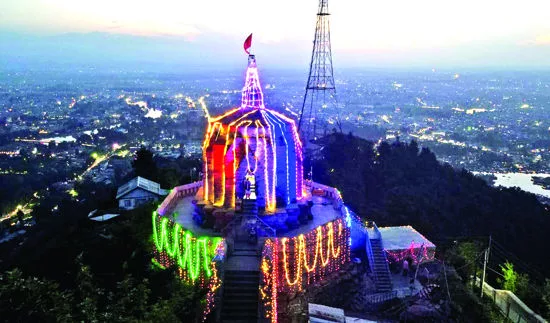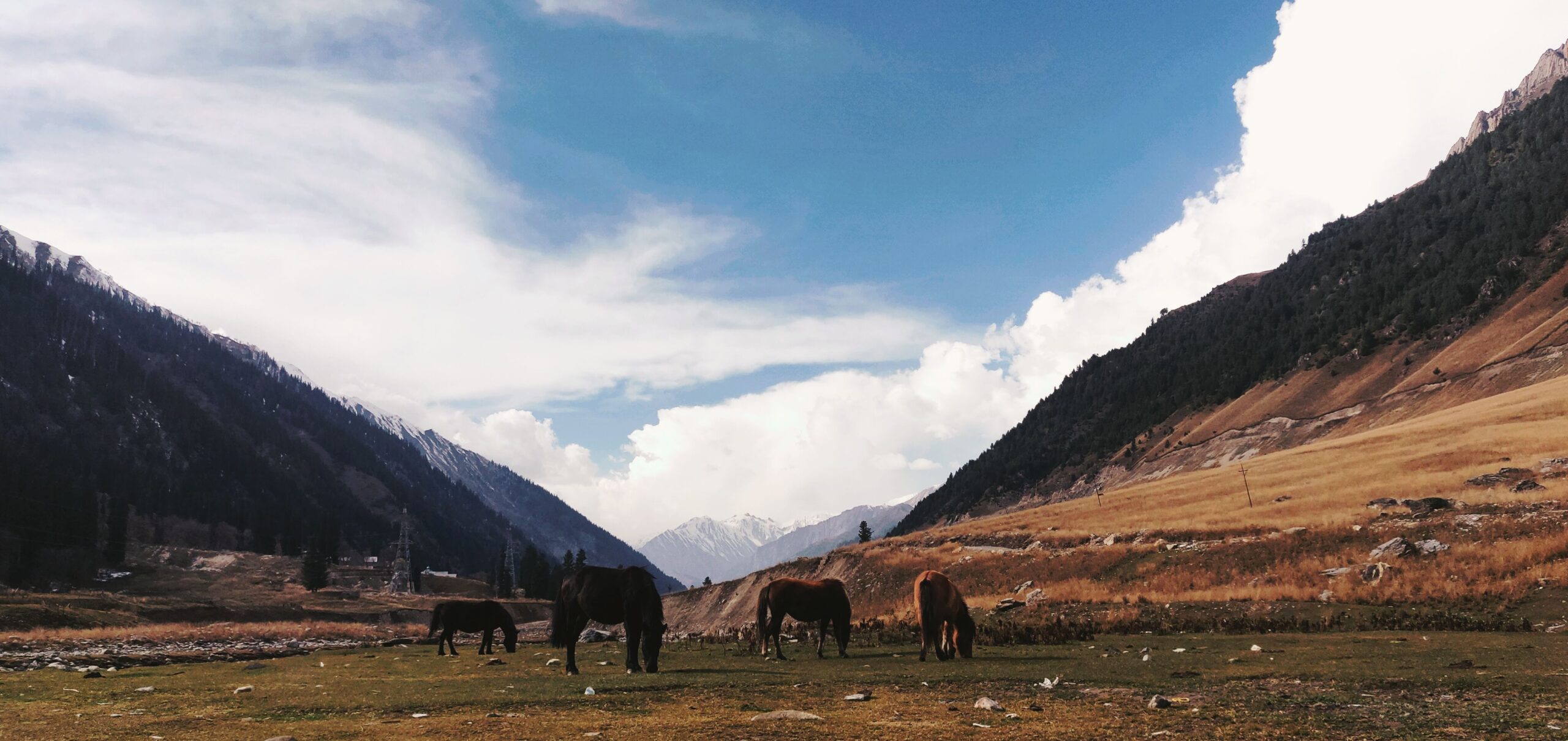
Shankaracharya Temple in Srinagar
Perched atop the towering Shankaracharya Hill, the Shankaracharya Temple in Srinagar stands as a silent sentinel to centuries of spirituality and devotion. Dedicated to Lord Shiva, this ancient shrine, also known as the Jyesteshwara Temple, is more than a religious edifice; it is a living testament to the intertwined threads of history, philosophy, and faith. In this exploration, we will delve deeper into the layers of this revered site i.e. The Shankaracharya Temple in Srinagar, discovering the intriguing history, awe-inspiring architecture, and the path that leads to its spiritual sanctuary.
The Legacy of Shankaracharya Temple
The Shankaracharya Temple holds a unique place in the hearts of the faithful because it has an association with the great philosopher Shankaracharya himself. Approximately ten centuries ago, this revered philosopher is believed to have visited Srinagar, commencing a transformative journey that would shape the course of Hindu philosophy. Here, atop the Shankaracharya Hill, he attained spiritual enlightenment.
This moment of awakening led Adi Shankaracharya to propagate the philosophy of Advaita, the doctrine of non-dualism, and establish the four Hindu schools of thought. The temple, home to the Shiva Linga he worshipped, carries the weight of this profound legacy, drawing pilgrims and travellers who seek spiritual connection and historical insights. It’s not just a temple; it’s a living repository of philosophy, history, and devotion.
A Place Where Faith Transcends Time
The history of Shankaracharya Temple transcends millennia, weaving together the narratives of different eras and belief systems. The roots of this sacred site trace back to 200 BC, a time when Buddhism significantly influenced the region. Believers maintain that the temple initially served as a place of Buddhist worship, reflecting its rich history and cultural amalgamation..
The temple is also known as the “Garden of King Solomon”, and within its precincts, Persian inscriptions tell tales of bygone times. Adi Shankaracharya’s visit to this place marks a crucial turning point in its history, as he is credited with converting this temple from a Buddhist place of worship to a Hindu sanctuary. While historians may debate the specifics, the temple, as we see it today, carries the echoes of both faiths.
The sacred Shiva Linga, which now resides within the temple, was enshrined here during the Sikh period in the 19th century. Another historical perspective suggests that the temple’s origin dates back to the reign of the Hindu king Sandiman, who ruled over Kashmir from 2629 BC to 2564 BC. Over the centuries, various prominent rulers have contributed to its maintenance and preservation, leaving behind their imprints on the temple’s storied walls.
Architectural Marvel of Shankaracharya Temple
The architectural grandeur of the Shankaracharya Temple is a testament to the masterful craftsmanship of a bygone era. This sacred edifice is perched on a raised octagonal platform, and reaching it requires ascending a flight of around 243 stone steps. These steps are not just a means of access but a symbolic journey towards spiritual awakening.
The walls of these steps bear inscriptions, whispering stories from the past, and leading to the grandeur of the temple. The main shrine, a circular chamber with a commanding view of the valley, showcases the world-renowned Dal Lake, painting an enchanting panorama for the soul. Maharaja Gulab Singh’s contribution can be seen in the construction of these stone steps, which remain sturdy and enduring even today.
The temple complex also includes two small buildings built for the residence of sadhus, or saints, who find solace in the peace and spirituality of this hallowed place. These structures enhance the temple’s serene ambiance and offer a space for reflection and devotion.
The Path to Shankaracharya Temple
Reaching the Shankaracharya Temple is relatively convenient, thanks to the regular bus services that connect it to different parts of Srinagar. However, for a more comfortable journey, taxis are readily available throughout the city. Upon reaching the base of the Shankaracharya Hill, a picturesque yet manageable walk leads to the temple.
As you embark on this pilgrimage, you’ll find that the journey to the temple is as much a part of the experience as the temple itself. Each step symbolizes a progression in your spiritual voyage, gradually distancing you from the worldly chaos below, and leading you into a realm of serenity and devotion.
Shankaracharya Temple: A Place of Reverence
The Shankaracharya Temple, located atop the Shankaracharya Hill, remains a focal point of spirituality and devotion. Its roots extend deep into the annals of history, drawing countless pilgrims and tourists, particularly during the Amarnath Yatra season.
Architectural Marvel
The architectural magnificence of the temple is a harmonious blend of aesthetics and function. The temple’s imposing 20-foot tall octagonal base supports the square building, housing a small, dimly lit circular chamber. Within this chamber, four octagonal pillars support the ceiling, encompassing a basin where a Shivalinga, encircled by a serpent, stands in silent reverence. The design’s symmetry and simplicity inspire serenity and spiritual introspection.
Choosing the Right Time for Your Visit
Timing your visit to the Shankaracharya Temple is vital for an enjoyable experience. The best time to explore its splendor is between May and September when the weather is at its most agreeable. The spring and summer months offer respite from the chilly winters, when Srinagar is often blanketed in snow.
Planning Ahead for Your Visit
To fully savor your visit, it’s essential to keep a few practical tips in mind. The temple authorities strictly prohibit cameras and phones within the temple premises, so ensure you leave them behind in your vehicle or hotel. Additionally, the temple’s vehicle entry closes at 5:00 pm, so plan your trip accordingly. To ensure a smooth ascent, we highly recommend comfortable footwear and a supply of water, considering the 243 steps that lead to the temple.
Witness the Spiritual and Scenic Beauty
The Shankaracharya Temple in Srinagar is not just a place of religious significance but a sanctuary of peace and contemplation. The serene ambiance and awe-inspiring views from the temple make it a must-visit for all travelers exploring the heart of Kashmir. As you climb the steps, you’re not just ascending to a place of worship but also taking a journey through history, philosophy, and the timeless beauty of the valley.
Exploring the Legacy of Adi Shankaracharya
The philosopher Adi Shankaracharya, a pivotal figure in the development of Hinduism, intrinsically links to the temple. His visit to this very place, where the temple now stands, marked a turning point in his spiritual journey. The temple, in his honor, has preserved the heritage of his teachings and his profound connection with Lord Shiva.
A Spiritual Retreat
The temple’s lofty location offers an unparalleled view of Srinagar City, the Dal Lake, and the surrounding landscapes. The serenity and spiritual energy that permeate this place make it an ideal destination for those seeking solace and introspection.
A Stairway to Divinity
The journey to the Shankaracharya Temple is as much a part of the experience as the temple itself. The 243 steps that lead to the temple are not merely a physical ascent; they are a metaphorical climb toward spiritual awakening and enlightenment. With every step, one leaves behind the chaos of the world below and ascends into a realm of peace and devotion.
A Testament to Eternal Devotion
Throughout its rich history, the temple has stood as a symbol of unwavering devotion. The contributions of kings and devotees over the centuries have ensured its survival and magnificence. So, From its origins as a Buddhist place of worship to its transformation into a Hindu sanctuary, the Shankaracharya Temple continues to be a place where faith, history, and spirituality converge.
Plan Your Visit to Shankaracharya Temple
Whether you seek spiritual enlightenment, historical exploration, or simply a serene retreat in the lap of nature, the Shankaracharya Temple in Srinagar offers it all. As you embark on this journey, remember to be respectful and considerate, for this temple is not just a place of worship but a living testament to centuries of devotion and reverence.
Conclusion
The Shankaracharya Temple is a place where time seems to stand still, and the world below fades into insignificance. As you stand on its hallowed grounds, you’ll feel the weight of history, the power of philosophy, and the serenity of spirituality all converging at this sacred site. It’s not merely a temple; it’s a portal to a deeper understanding of faith, a connection to the past, and an encounter with the timeless beauty of the valley that surrounds it. So, when you venture to Srinagar, don’t miss the opportunity to explore the mystique of the Shankaracharya Temple, where devotion transcends time.
So, Checkout Our Kashmir Tour Packages in 2024
Also, Read Our Other Blogs Here
3 thoughts on “Shankaracharya Temple in Srinagar”
Add a Comment Cancel reply
All Categories
Recent Posts
Detailed Analysis: Impact on Tourism in Kashmir Post-April 22 Attack
Best Time to Visit Doodhpathri – The Milky Meadows of Kashmir
Baisaran Valley Pahalgam






[…] to a higher plane, we make our way to the Shankaracharya Temple, perched atop the Shankaracharya Hill. The panoramic views that unfold during the climb provide a […]
[…] connection with the serene natural surroundings. Popular trekking spots in Srinagar include Shankaracharya Hill and Hari Parbat, which Should be on the list of your Top 15 Things To Do In […]
[…] and the breath taking Dal Lake. Nearby attractions include the Chashme Shahi Garden, Pari Mahal, Shankaracharya Temple, Dal Lake, Nishat Gardens, Mughal Gardens, Shalimar Bagh, Nagin Lake, Hazratbal, and vibrant local […]